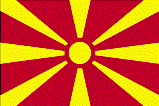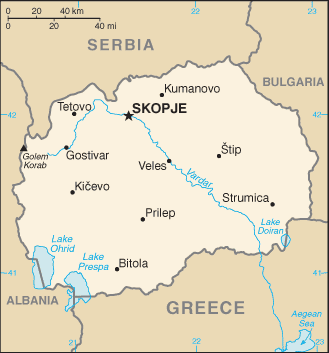|
North Macedonia
|

|
Capital: Skopje
Population: 2,083,459
Brief History of North Macedonia:
The area that is today North Macedonia has long been a crossroads for traders and conquerors traveling between Asia and Europe. The area was often inhabited by tribes and city-states. In 356 BC Philip II of Macedon united much of the area under one rule. His son, Alexander the Great, would create a huge empire encompassing much of Asia Minor, Egypt, and the Mediterranean. After the Greeks, the Romans would control the area followed by the Byzantine Empire. In the 15th century the Ottoman Empire took over and ruled until 1912.
After World War I, Macedonia became part of Yugoslavia. It gained its independence from Yugoslavia in 1991. In the following years there were many disagreements with the country of Greece as it objected to North Macedonia's use of Hellenic (Ancient Greek) names and symbols.
The Geography of North Macedonia
Total Size: 25,333 square km
Size Comparison: slightly larger than Vermont
Geographical Coordinates: 41 50 N, 22 00 E
World Region or Continent: Europe
General Terrain: mountainous territory covered with deep basins and valleys; three large lakes, each divided by a frontier line; country bisected by the Vardar River
Geographical Low Point: Vardar River 50 m
Geographical High Point: Golem Korab (Maja e Korabit) 2,764 m
Climate: warm, dry summers and autumns; relatively cold winters with heavy snowfall
Major cities: SKOPJE (capital) 480,000 (2009)
The People of North Macedonia
Type of Government: parliamentary democracy
Languages Spoken: Macedonian 66.5%, Albanian 25.1%, Turkish 3.5%, Roma 1.9%, Serbian 1.2%, other 1.8% (2002 census)
Independence: 8 September 1991 (referendum by registered voters endorsing independence from Yugoslavia)
National Holiday: Uprising Day, 2 August (1903); note - also known as Saint Elijah's Day and Ilinden
Nationality: Macedonian(s)
Religions: Macedonian Orthodox 64.7%, other Christian 0.37%, Muslim 33.3%, other and unspecified 1.63% (2002 census)
National Symbol: eight-rayed sun
National Anthem or Song: Denes Nad Makedonija (Today Over Macedonia)
Economy of North Macedonia
Major Industries: food processing, beverages, textiles, chemicals, steel, cement, energy, pharmaceuticals
Agricultural Products: grapes, wine, tobacco, vegetables; milk, eggs
Natural Resources: low-grade iron ore, copper, lead, zinc, chromite, manganese, nickel, tungsten, gold, silver, asbestos, gypsum, timber, arable land
Major Exports: food, beverages, tobacco; miscellaneous manufactures, iron and steel
Major Imports: machinery and equipment, automobiles, chemicals, fuels, food products
Currency: Macedonian denar (MKD)
National GDP: $21,590,000,000
** Source for population (2012 est.) and GDP (2011 est.) is CIA World Factbook.
Back to Geography Home Page
